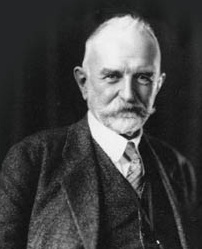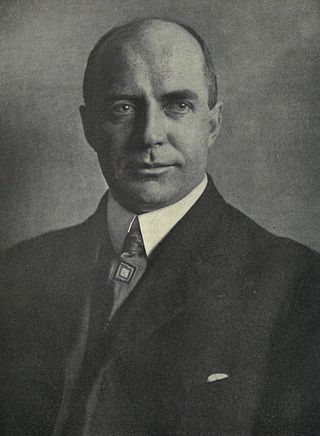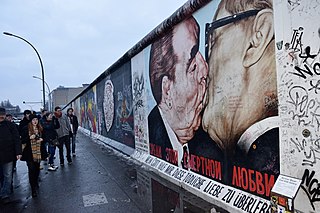
Erving Goffman was a Canadian-born American sociologist, social psychologist, and writer, considered by some "the most influential American sociologist of the twentieth century".

Symbolic interactionism is a sociological theory that develops from practical considerations and alludes to humans' particular use of shared language to create common symbols and meanings, for use in both intra- and interpersonal communication. According to Macionis, symbolic interactionism is "a framework for building theory that sees society as the product of everyday interactions of individuals". In other words, it is a frame of reference to better understand how individuals interact with one another to create symbolic worlds, and in return, how these worlds shape individual behaviors. It is a framework that helps understand how society is preserved and created through repeated interactions between individuals. The interpretation process that occurs between interactions helps create and recreate meaning. It is the shared understanding and interpretations of meaning that affect the interaction between individuals. Individuals act on the premise of a shared understanding of meaning within their social context. Thus, interaction and behavior is framed through the shared meaning that objects and concepts have attached to them. From this view, people live in both natural and symbolic environments.

George Herbert Mead was an American philosopher, sociologist, and psychologist, primarily affiliated with the University of Chicago. He was one of the key figures in the development of pragmatism. He is regarded as one of the founders of symbolic interactionism, and was an important influence on what has come to be referred to as the Chicago School of Sociology.

In micro-sociology, interactionism is a theoretical perspective that sees social behavior as an interactive product of the individual and the situation. In other words, it derives social processes from social interaction, whereby subjectively held meanings are integral to explaining or understanding social behavior.

Charles Horton Cooley was an American sociologist. He was the son of Michigan Supreme Court Judge Thomas M. Cooley. He studied and went on to teach economics and sociology at the University of Michigan. He was a founding member of the American Sociological Association in 1905 and became its eighth president in 1918. He is perhaps best known for his concept of the looking-glass self, which is the concept that a person's self grows out of society's interpersonal interactions and the perceptions of others. Cooley's health began to deteriorate in 1928. He was diagnosed with an unidentified form of cancer in March 1929 and died two months later.

Labeling theory posits that self-identity and the behavior of individuals may be determined or influenced by the terms used to describe or classify them. It is associated with the concepts of self-fulfilling prophecy and stereotyping. Labeling theory holds that deviance is not inherent in an act, but instead focuses on the tendency of majorities to negatively label minorities or those seen as deviant from standard cultural norms. The theory was prominent during the 1960s and 1970s, and some modified versions of the theory have developed and are still currently popular. Stigma is defined as a powerfully negative label that changes a person's self-concept and social identity.

Microsociology is one of the main levels of analysis of sociology, concerning the nature of everyday human social interactions and agency on a small scale: face to face. Microsociology is based on subjective interpretative analysis rather than statistical or empirical observation, and shares close association with the philosophy of phenomenology. Methods include symbolic interactionism and ethnomethodology; ethnomethodology in particular has led to many academic sub-divisions and studies such as micro-linguistical research and other related aspects of human social behaviour. Macrosociology, by contrast, concerns the social structure and broader systems.
Herbert George Blumer was an American sociologist whose main scholarly interests were symbolic interactionism and methods of social research. Believing that individuals create social reality through collective and individual action, he was an avid interpreter and proponent of George Herbert Mead's social psychology, which he labeled symbolic interactionism. Blumer elaborated and developed this line of thought in a series of articles, many of which were brought together in the book Symbolic Interactionism. An ongoing theme throughout his work, he argued that the creation of social reality is a continuous process. Blumer was also a vociferous critic of positivistic methodological ideas in sociology.

William Isaac Thomas was an American sociologist, understood today as a key figure behind the theory of symbolic interactionism.
The Thomas theorem is a theory of sociology which was formulated in 1928 by William Isaac Thomas and Dorothy Swaine Thomas:
If men define situations as real, they are real in their consequences.
A label is an abstract concept in sociology used to group people together based on perceived or held identity. Labels are a mode of identifying social groups. Labels can create a sense of community within groups, but they can also cause harm when used to separate individuals and groups from mainstream society. Individuals may choose a label, or they may be assigned one by others. The act of labeling may affect an individual's behavior and their reactions to the social world.

A sociological theory is a supposition that intends to consider, analyze, and/or explain objects of social reality from a sociological perspective, drawing connections between individual concepts in order to organize and substantiate sociological knowledge. Hence, such knowledge is composed of complex theoretical frameworks and methodology.

Mathematical sociology is an interdisciplinary field of research concerned with the use of mathematics within sociological research.
In control theory, affect control theory proposes that individuals maintain affective meanings through their actions and interpretations of events. The activity of social institutions occurs through maintenance of culturally based affective meanings.

The sociology of emotions applies sociological theorems and techniques to the study of human emotions. As sociology emerged primarily as a reaction to the negative effects of modernity, many normative theories deal in some sense with emotion without forming a part of any specific subdiscipline: Karl Marx described capitalism as detrimental to personal 'species-being', Georg Simmel wrote of the deindividualizing tendencies of 'the metropolis', and Max Weber's work dealt with the rationalizing effect of modernity in general.

Sociology is the study of human society that focuses on society, human social behavior, patterns of social relationships, social interaction, and aspects of culture associated with everyday life. Regarded as a part of both the social sciences and humanities, sociology uses various methods of empirical investigation and critical analysis to develop a body of knowledge about social order and social change. Sociological subject matter ranges from micro-level analyses of individual interaction and agency to macro-level analyses of social systems and social structure. Applied sociological research may be applied directly to social policy and welfare, whereas theoretical approaches may focus on the understanding of social processes and phenomenological method.
Impression formation in social psychology refers to the processes by which different pieces of knowledge about another are combined into a global or summary impression. Social psychologist Solomon Asch is credited with the seminal research on impression formation and conducted research on how individuals integrate information about personality traits. Two major theories have been proposed to explain how this process of integration takes place. The Gestalt approach views the formation of a general impression as the sum of several interrelated impressions. As an individual seeks to form a coherent and meaningful impression of another individual, previous impressions significantly influence the interpretation of subsequent information. In contrast to the Gestalt approach, the cognitive algebra approach asserts that individuals' experiences are combined with previous evaluations to form a constantly changing impression of a person. A related area to impression formation is the study of person perception, making dispositional attributions, and then adjusting those inferences based on the information available.
David Reuben Jerome Heise was a social psychologist who originated the idea that affectual processes control interpersonal behavior. He contributed to both quantitative and qualitative methodology in sociology. He retired from undergraduate teaching in 2002, but continued research and graduate student consulting as Rudy Professor of Sociology Emeritus at Indiana University. He was most well known for his work on affect control theory.

Mind, Self, and Society is a book based on the teaching of American sociologist George Herbert Mead's, published posthumously in 1934 by his students. It is credited as the basis for the theory of symbolic interactionism. Charles W. Morris edition of Mind, Self, and Society initiated controversies about authorship because the book was based on oral discourse and Mead's students notes. Nevertheless, the compilation of his students represents Mead’s most important work in the social sciences. Among them, Mead published a conceptual view of human behaviour, interaction and organization, including various schools of thought such as role theory, folklore methodology, symbolic interactionism, cognitive sociology, action theory, and phenomenology.
Biographical research is a qualitative research approach aligned to the social interpretive paradigm of research. The biographical research is concerned with the reconstruction of life histories and the constitution of meaning based on biographical narratives and documents. The material for analysis consists of interview protocols (memorandums), video recordings, photographs, and a diversity of sources. These documents are evaluated and interpreted according to specific rules and criteria. The starting point for this approach is the understanding of an individual biography in terms of its social constitution. The biographical approach was influenced by the symbolic interactionism, the phenomenological sociology of knowledge, and ethnomethodology. Therefore, biography is understood in terms of a social construct and the reconstruction of biographies can give insight on social processes and figurations, thus helping to bridge the gap between micro-, meso-, and macro- levels of analysis. The biographical approach is particularly important in German sociology. This approach is used in the Social Sciences as well as in Pedagogy and other disciplines. The Research Committee 38 "Biography and Society" of the International Sociological Association (ISA) was created in 1984 and is dedicated "to help develop a better understanding of the relations between individual lives, the social structures and historical processes within which they take shape and which they contribute to shape, and the individual accounts of biographical experience ".









